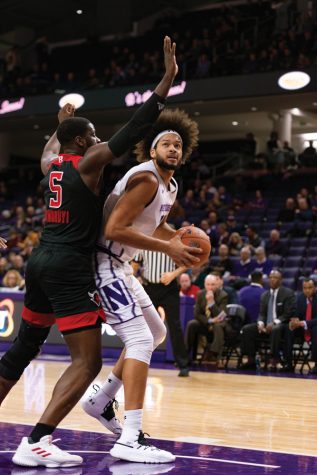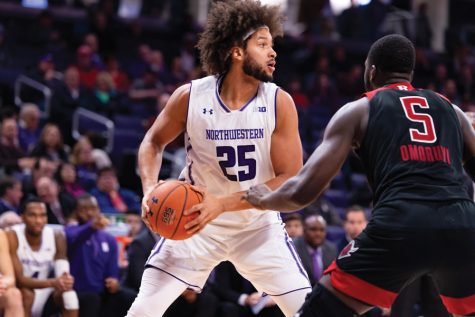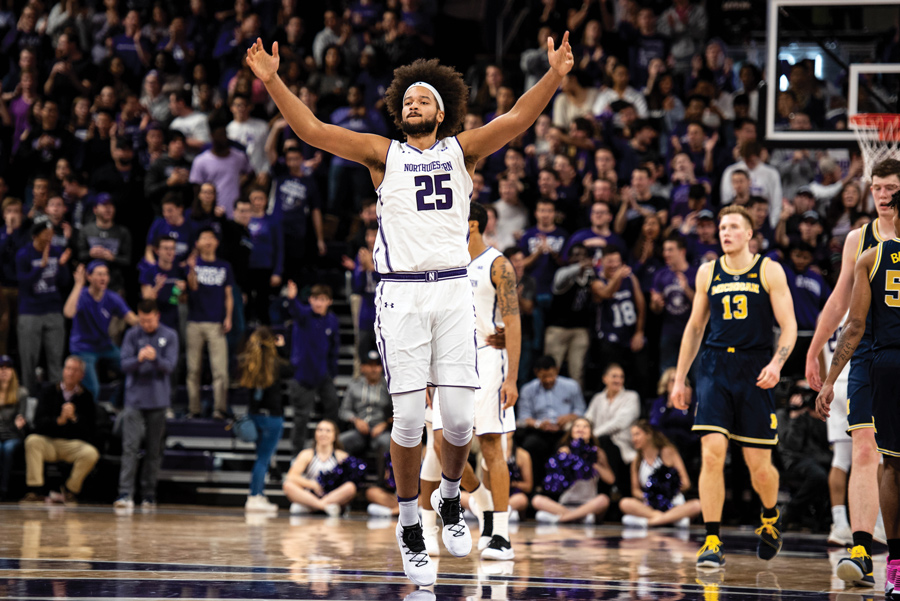Front and center: Barret Benson’s development is worth watching
February 27, 2019
Men’s Basketball
Nearly four years ago, back when the old Welsh-Ryan Arena was still kicking and before he started growing his signature afro, Barret Benson had to try to coexist.
The 6-foot-10 center, ranked No. 79 in his high school class, was invited to an NBA Players Association Top 100 camp. When he got there, Benson realized he’d be playing with internet sensation Thon Maker, a 7-foot-1 big from South Sudan whose highlight reel reached over one million views on YouTube.
Maker could post-up, face-up and knock down threes. In his YouTube reel, he resembled a taller Kevin Durant, and Maker was drafted No. 10 in the 2016 NBA Draft without playing a game of college ball, a selection based solely off his potential.
Benson was highly accomplished in his own right, ranked by ESPN as the No. 3 player in Illinois and the No. 22 center in his class. But he was no Thon Maker. So at the camp, coached by Garrett Temple of the Los Angeles Clippers, Benson played out of position on a team that also featured a guard (Michigan’s Zavier Simpson) and a forward (Michigan State’s Xavier Tillman) who can’t shoot the three-ball much better than Benson can.
“Most of the time, we just gave it to Thon, of course,” Benson told The Daily. “It was just like give it to him and let him go to work with his faceup, post game, anything.”
Benson struggled in a role that sounds identical to the one he has as a junior at Northwestern (12-15, 3-13 Big Ten).
Benson has been in and out of the starting lineup over the last few weeks. Either he shares the floor with senior center Dererk Pardon, a commanding force like Maker in the lane, or Benson gets spot minutes when the 13.7 point per game scorer needs a breather.
Despite the Wildcats having an offense that’s been worse than their defense, coach Chris Collins said he made a defense-first move in starting Benson and Pardon together against Rutgers on Jan. 18. After a brief hiatus, they’ve started together 4 of the last 6 games, and in the contests Benson has started, NU averages just 59.8 points per game.
Benson said he thinks those lineups have had success because they present unique mismatches to both small teams and big teams.
“With two options in the post now, they’re going to have to guard both of us,” Benson said. “And do it with someone smaller. For smaller teams, we pack it in. And then of course we match up with other two-big teams really well.”
When Collins and assistant coach Brian James decided to give Benson a shot with the starters, they realized they would have to remodel parts of the playbook. It was hard enough finding open shots when the starting lineup featured two consistent perimeter shooters. But in some matchups, the team needed Benson’s rebounding and energy more than it wanted freshman forward Miller Kopp’s perimeter shooting. So they went to the drawing board to design an offense for a starting lineup that would now include just one deep threat.
“We have more plays in our playbook the other way, but we’ve done some good things with our double big lineup,” James told The Daily. “We’re probably right now just not as fluid offensively as we are doing the other just because we have more experience playing two smaller forwards and a center.”
James acknowledged that Benson hasn’t been the consistent offensive player he was in high school in his first three seasons in Evanston. Benson averages 2.3 points on 37.5 percent shooting as a junior, and he shoots just 52.9 percent at the rim.

Barret Benson looks towards the basket. The junior center shoots just under 53 percent at the rim.
Benson practices several of the same moves as Pardon, one of the most efficient bigs in the country. But despite being two inches taller than his teammate, Benson has a more difficult time powering through post defenders and putting up a smooth hook shot.
Benson has also been inconsistent on putback attempts, shooting only 50 percent on those lightly contested layups following an offensive rebound.
“He’s not shooting the percentage that he would like or I would like or our team would like,” James said. “It’s all about confidence, getting reps, getting his game back.”
But NU trying to play a copycat small ball style wasn’t working either. The Cats don’t have the shooters to accomplish that, but they are one of the few teams in the Big Ten that has two traditional post players. Enter Benson. Looking forward to Thursday’s game against Minnesota, James said he envisions a Benson-Pardon starting front court to match up with the Golden Gophers’ Jordan Murphy and Daniel Oturu.
Murphy scores 14.9 points per game and is one of the best offensive rebounders in the country, while Oturu is an elite shot blocker and excellent dunker. Pardon will likely start defending Murphy, and Benson will take the 6-foot-10 Oturu. Whether the Cats will be able to crack 60 points on Thursday with this lineup remains to be seen, but James said it gives the team the look it’s going to need.
“Even though we may not be as fluid offensively (with Benson at the four), we at times are better defensively when he’s in,” James said. “You have to find that balance. If you get stops, then we get run outs in transition.”
Since this experiment started, James said he’s analyzed NU’s lineup data, comparing how the team looks with Benson at the four with how it looks playing a more conventional lineup.
Over the last five games, the Benson-Pardon lineup is the Cats’ most used frontcourt, but playing them together hasn’t helped the team’s offense on paper. James said there are other factors than point differential that he analyzes, including the shooting efficiency and shot quality of both teams. That data gives the coaches more confidence playing two bigs together, despite the offense continuing to struggle.
At the end of the season, NU will lose its three leading scorers in senior forward Vic Law, graduate guard Ryan Taylor and Pardon. So the last-place team in the Big Ten will have to replace its most dynamic playmaker off the dribble, its most aggressive perimeter shooter and the post player the team centers its offense around.

Barret Benson looks to pass. The junior center has started five games this year.
That leaves two choices for the coaching staff. They could plug Benson into Pardon’s center spot next season and roll with the experienced big. Or the Cats, who’ll be an extremely young team in 2019-20, could make a 180-degree turn.
Looking at the team’s projected rotation next season, NU’s most talented players will be sophomore guard Anthony Gaines, freshmen forwards Pete Nance and Kopp and incoming freshmen Robbie Beran, a sweet-shooting forward ranked No. 80 in his class by 247Sports. While all four of them are capable perimeter shooters, that core features no point guard or traditional center. You can only start five players, so the lineup can’t have both a lead ball handler and a rim protector.
Next season, Collins will have to answer a fundamental question about how he wants to play — specifically whether he’d prefer spacing and shooting or defensive rebounding and rim protection.
If, for the sake of player development, Collins decides to start those four guys, that leaves one spot left in the starting lineup. He could choose Benson and run an offense similar to the four-around-one motion offense he used at the start of the season. Or he could scrap that.
A lineup featuring Nance and Beran at the four and the five is almost certain to have a difficult time defensively, as neither of them are strong enough yet to defend traditional post scorers or keep the best rebounders off the glass. But Nance and Beran can spread the floor and handle the ball better than any other forward Collins has recruited, opening a world of possibilities if the skilled forwards play together.
Also, redshirt Ryan Young and incoming freshman Jared Jones offer more explosiveness than Benson at the center position and could gain significant minutes as well.
If Benson’s post attempts start falling down the stretch of this season, and if he shows signs of becoming a more complete post player, Benson could become a major part of NU’s plans for next season. He has four regular season games remaining, and with this starting role he has the opportunity to begin reshaping the narrative that he can be a part of a high-octane offense.
But even though he’s a starter now, Benson’s role remains in flux. The Cats go away from Benson when they face high octane teams that feature a perimeter shooter at the four.
Saturday against Wisconsin, Benson played just three minutes despite the Badgers starting a 6-foot-11 forward, Nate Reuvers, since Reuvers rarely posts up or crashes the glass. Starting a smaller lineup featuring Kopp at the four, NU had 1.02 points per possession, which was its third-highest figure in Big Ten play all year.
If the Cats commit to playing that uptempo style full-time next season, it remains to be seen how Benson would fit into the rotation. Benson himself has no clue what to expect.
“I don’t know if I’ll start next year,” he said. “We’ll see what happens.”
Email: [email protected]
Twitter: @2021_charlie

